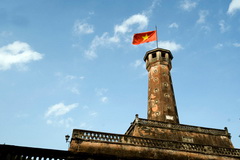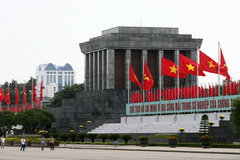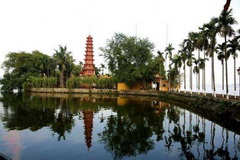



If you are touring along Tran Quang Khai road or Tong Dan street, chances are that you will be stopped out of curiosity and admiration by the unique French style architecture of Vietnam Museum of Revolution. Built in 1917 by the French colony, the place is now dedicated to displaying artifacts, documentaries and sporadic exhibitions about Vietnamese’s struggle inmodern history. The content is divided into three parts, 1858-1945; 1945- 1975 and 1975-now, which correspond with the French colonialism period, the Vietnam War period and the Post-war period. As impressive as the range of topics covered is the interior and exterior design of the building, which can be found only in other historic places put up during the early 20th century inHanoi.
.jpg)
Son Dong Religious items VillageAddress: Son Dong Village, Hoai Duc district, HanoiProducts: Handmade carved religious kitsLying about 15km from Hanoi center, Son Dong traditional craft village (Hoai Duc, Hanoi) is known for its well-preserved cultural essences in folk sculptures. Throughout so...

Hanoi Flag Tower at the age of nearly 200 years is renowned as one of the symbols of Hanoi. The construction began in 1805 and completed in 1812, the 11th year of Gia Long time, Nguyen dynasty, five years after construction time of Flag Tower in Hue.From 1894 to 1897, the French colonial...
.jpg)
Quat Dong Embroidery VillageAddress: Quat Dong Village, Quat Dong commune, Thuong Tin district, Hanoi Products: Embroidered productsWhenever talking about Vietnamese traditional embroidery, people often mention to Quat Dong - ancestor of the embroidery with all the respect and pride. With...

Le pont permet au Chemin de fer Nord-Sud du Viêt Nam venant de Hô-Chi-Minh-Ville de franchir le fleuve Rouge après la gare de Hanoï et de continuer sur la rive gauche du fleuve vers Lào Cai pour ensuite se diriger vers le Yunnan en Chine. Il est de type à...

The square adjacent to the Ho Chi Minh complex is called Ba Dinh square, where many important national historical events in modern history took place. The square was originally developed by French colony and known as Round Point Pugininer. On September 2nd, 1945 – now Vietnam...

Tran Quoc Pagoda is located on an islet of West Lake in Ha Noi. Tran Quoc Pagoda is one of the oldest pagodas in Viet Nam and a cultural symbol of Vietnamese Buddhism.It is said that, the pagoda was built under the reign of King Ly Nam De (544-548) under its original name of Khai Quoc (National...
.jpg)
Ha Thai Lacquer-ware VillageAddress: Ha Thai village, Duyen Thai commune, Thuong Tin district, Hanoi.Products: Lacquer painting productsHa Thai village – Duyen Thai commune is located right by side of 1A national highway and among other famous trade villages. Ha Thai village’s lacquer...

La pagode du Pilier unique est un adorable pagodon au milieu d’un bassin où fleurissent les lotus en été. Édifié au XIe siècle. Avec la petite pagode voisine et le jardin, l’ensemble se révèle bien charmantLa pagode au pillier a...
.jpg)
Cu Da Vermicelli VillageAddress: Cu Da village, Cu Khe, Thanh Oai district, Hanoi.Products: handmade vermicelli of dong rice powder.Just 20km from busy downtown Hanoi lies Cu Da Vermicelli Village, long known for its vermicelli noodles. Lying beside the calm Nhue River, Cu Da Village is a lovely...

Environ 10 km au Sud-Est du centre d’Hanoï, vous pouvez y aller en bus ou à vélo. Avec 500 ans de développement, le village de céramique Bat Trang attire annuellement des milliers de visiteurs. En venant ici, vous pouvez non seulement explorer la...

Soyez le premier à connaître nos offres de voyage exclusives et les nouveaux circuits !.